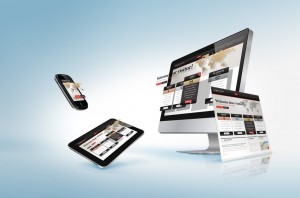WEB DESIGN
What Is Web Design?
The Planning Process
Web Design is primarily the process of planning and creating a website. This planning and creation includes all aspects of a website such as site structure, layout, fonts, colors, user interface, information architecture and imagery. A web design is said to be effective when all these characteristics of a website are created by keeping the principles of design in mind to meet the goals of the designer as well as the owner of the website.
The Design Process
Design is a major element of web design. It encompasses all facets of a website that go into making its facade such as lines, texture, shape, direction and color. However, it must be remembered that usability and utility score more over visual design when it comes to determining the success or failure of a website. The fact that every website is targeted at a user, user centric design has gained fast acceptance as a standard approach for a profitable and successful web design.
Web Design Examples
Parallex
Here are some tips on web design that will put life into an already existing dull website design or inspire you to create a new and user friendly web design. Parallax – Use scrolling for engagement. It may be hard to believe but just a single change in the design of your website can increase your customer engagement by 70%. Parallax scrolling provides an eye catching experience of delivering a message visually. Parallax scrolling is essentially the act of moving several elements individually as the user scrolls down the page. Such an experience encourages the user to scroll further down and makes the user spend more time on the page.
Symbols and Icons
Symbols and iconography: The visual – Information rich sites have a lot of text that describes what is on the page. This makes it important for  the designers to present text in such a manner that it has maximum impact on the reader. This can be achieved by using icons which will not only demonstrate the concepts that they have been used with but also help in guiding the user’s eye from one place to the other in a manner similar to a visual signpost.
the designers to present text in such a manner that it has maximum impact on the reader. This can be achieved by using icons which will not only demonstrate the concepts that they have been used with but also help in guiding the user’s eye from one place to the other in a manner similar to a visual signpost.
Icons had been implemented as bitmap graphics in earlier days. They were both difficult to style as well as cumbersome to implement. These days, designers have started making use of icon fonts to generate glyphs which have all the properties of text viz. they are infinitely scalable, vector based and are customizable via the CSS. When icons start supporting content, paragraphs in the text become more than just text and when combined with dynamic topography, they make the website easy to read.
For instance, a website could offer an e-book download for free as a reward for tweeting a link to the website. Such small things go a long way in personalizing the user experience and encourage engagement with the user.
Responsive Web Design
Flexible typography: Responsive design for content – Responsive web design is more than just being about layout. It has as much to do with content as with the layout of the webpage. While it shall be great that the layout adapts to the size of the screen it is being viewed upon, it shall be equally important that the content’ adapts to the screen size too.
Animated Web Design
Animations can say so much: Site design using animated interaction displays are captivating and fun. How can you express your business or brand using animated ideas that show what you are offering? Communications on a website do not have to be expressed through content alone. Illustration design to immediately capture the viewer’s attention is the key. A functional enhancement of an idea….

